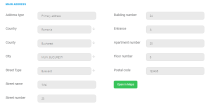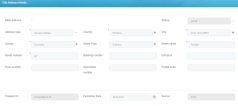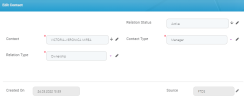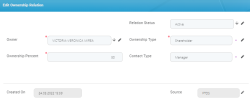Define Profile
You can see an overview of the customer's profile, identification data, contact information, shareholders, timezone preferences, registered complaints, and their relationship with the bank (assigned bank division, business line, branch, and others) in the Profile tab.
All the data related to the customer's account is stored in the Account Information section:
-
Name: Enter the customer's business name.
-
Fiscal Residence: Select the jurisdiction where the company is registered for tax purposes.
-
Legal Form: Select the legal form of the customer's business. Select from the following options:
-
S.R.L. for limited liability companies
-
S.A. for joint stock companies
-
-
Residence Status: Select the residence status: Resident or Non-resident.
-
Unique Taxpayer Reference (UTR): Enter the company’s fiscal registration number.
-
Foundation Date: Enter The foundation date of the business.
-
PIN: For legal entities, this field is displayed only for Self Employed Individual account types and when the is Person field is
true. For additional details see the Define Account Types section. -
Registration Number: Enter the registration number of the business. A registration number is a unique number that can be found on the business's incorporation certificate.
-
Primary Activity Domain: Select the legal entity's primary activity domain.
-
Registration Date: Enter the registration date of the legal entity.
-
Primary Activity Domain: Select the business's primary activity domain.
-
Industry: Select the company’s industry sector. Select from the following options: Accounting, Agriculture, Technology, Products, Technology, Software Provider or Telecommunications
-
Unique Register Type: Enter the legal entity's unique register type.
-
VAT Number: Enter a code that identifies the legal entity as a VAT payer.
-
Registration Authority: Enter the company registration agency authorised to issue company licenses.
-
SIC Code: Enter the Standard Industrial Classification system used to classify the company’s industry area, such as CAEN, NAICS, ISIC, or GICS.
-
Registration Document Type: Enter the registration document type.
-
Account type: Select the customer's account type. Select a value form the list or create a new one. Possible values:
-
Legal person: for legal entities, the unique identifier is the Unique Taxpayer Reference (UTR)
-
Self employed individual: for self employed individuals, the unique identifier is the person's Personal Identification Number (PIN) and Unique Taxpayer Reference (UTR).
-
-
Website: Enter the legal entity's website.
-
Customer Segment: Select the market segment classification of the company, such as Micro or SME. The following options are available: UHNW, Mass Market, Mass Affluent, Affluent, Private Banking or HNW
-
Division: Select the business division to which the customer belongs.
-
Customer Subsegment: Select the market segment classification of the company, such as Micro or SME. The following options are available: UHNW, Mass Market, Mass Affluent, Affluent, Private Banking or HNW
-
Business Line: Select the division’s business line to which the customer belongs. For more information, see the Define Business Lines section.
-
Account responsible: Select the employee responsible for the customer's account.
-
Branch: Select the business branch to which the customer belongs to.
-
Source: The record source. If the customer's profile is created through the FintechOS Portal, then the FTOS value is displayed. For external sources, the name of that particular source is displayed.
The customer's primary address is stored in the Main Address section. An account can have more than one address but only one primary address.
Use the Open in Maps button to locate the main address in Google Maps.
In case a main address hasn't been set for the account, the main address is set automatically based on the following formula:
- If the account has one address (with an Active status), then the address is set as the main address.
- If there is no address with an Active status set, then the most recent Address type 1 is set as the main address.
- If there is no Address type 1 found, then the most recent Address type 2 is set as the main address.
- If there is no Address type 2 found, then the most recent Address type 3 is set as the main address.
If there aren't any valid addresses found on the customer's account, then you can't set the address as main.
You can store multiple addresses for the company, such as the headquarters address, branch addresses, billing address, or delivery addresses, in the Addresses section. Select either Active or Inactive from the drop-down list to filter the records.
Active addresses are valid, up-to-date addresses that the customer uses at the present moment. Inactive addresses are addresses that are no longer in use by the customer.
You can add addresses manually by inputting the address details or by using the OCR functionality where the details are extracted automatically from the customer's identity document. When creating a new address:
-
Click the Insert button and fill in the following fields:
-
Main Address: If this checkbox is selected, then the record is set as the main address.
-
Status: Enter the status of the number: active or inactive.
-
Address Type: Select the address type from the following options: Primary Address, Secondary Address, Billing Address, Social Address, Delivery Address, Home Address or Residence Address
-
Country: Select the country from the customer's address.
-
City: Select the city from the customer's address.
-
County: Select the county from the customer's address.
-
Street Type: Select the street type from the customer's address. Select from the existing records or insert a new one.
-
Enter the Street Name, Street Number, Building number, Entrance, Floor Number, Apartment Number and Postal Code from the customer's address.
-
-
Once finished adding the address details, click either Save and Close, or Save and Reload to continue to edit the record.
-
The Edit Address Details page displays, and from here, you can set a record to be Inactive by setting the following fields:
-
Created On: Enter the creation date of the record.
-
Expiration Date: Enter the date the record is set to expire. Once this field is set, the record status is automatically changed to Inactive when the expiration date is set in the past compared to the system date.
-
Source: Enter the record source. If the record is created through the FintechOS, then the FTOS value is displayed. For external sources, the name of that particular source is displayed.
-
The customer's active or inactive phone numbers are stored in the Phone Numbers section. Here, you can set their main office phone number and even their landline or fax number. By default, the active phone numbers are displayed. Select the Inactive status to see the phone numbers that are no longer used by the customer.
-
To create a new phone number record, click the Insert button and fill in the following fields:
-
Main Phone Number: You can manually set the main phone number. If the main phone number is inactive, deleted, or there is no main phone number set, the system automatically determines the most recent phone number as main.
-
Status: Select the status of the number: active or inactive.
-
Type: Select the phone number type from the following options: Mobile, Landline, Fax, National or International.
-
Usage: Select the phone number usage from the following options: Work, Personal, Home or Office.
-
Phone Number: Input the phone number.
-
-
Click the Save and reload button.
The customer's email addresses are stored in the Email Addresses section. Here, you can set the customer's business, or marketing email address. By default, the active email addresses are displayed. Select the Inactive status to see the email addresses that are no longer used by the customer.
-
To create a new email record, click the Insert button and fill in the following fields:
-
Main Email Address: You can set the main email address manually. If the main email address is inactive, deleted, or there is no main email address set, the system automatically determines the most recent email address as main.
-
Status: Enter the status of the number: active or inactive.
-
Email Address Type: Select the phone number type from the following options: Business, Personal, Marketing or Other.
-
Email Address: Input the email address.
-
-
Click the Save and reload button.
You can find the company’s legal representatives, such as administrators, affiliates, owners, or other key contact persons, listed in the Contracts section.
If the Relationship Type field is set to either Shareholder, Affiliate, or Participant, the Ownership Percent field is displayed and a value must be inputted.
In this case, the contact person is also a shareholder and the record is displayed both in the Contacts and the Shareholders sections.

-
To add a new contact record, click the Insert button and fill in the following fields:
-
Contact: Select the contact name from the list or create a new one.
-
Contact Type: Select the contact type from the following options: Administrator, Clerk, Legal Representative, Manager, Secretary or 3rd Party.
-
Relation Type: Select the relation type from the following options: Hierarchy, Participant, Administrator, Shareholder, Relative, Contact, Business, Affiliate, Ownership, Employer or Key Contact Person.
-
Ownership Percent: Set the contact's ownership percentage. This field is displayed only if the Relationship Type field is set to either Shareholder, Affiliate, or Participant.
-
-
Once finished adding the contact details, click either Save and Close, or Save and Reload to continue to edit the record.
-
After clicking the Save and Reload button, the Edit Contact page displays and from here, you can set a record to be Inactive or Active from the Relation Status field.
A shareholder can also be a contact if a value is set in the Contact Type field.
The company’s shareholders are listed in the Shareholders section. A shareholder is a person, company, or institution that own at least one share of a company's stock.
Ownership of all active owners cannot exceed 100%. When new shareholders, participants, or affiliates are added to the account, the total ownership value is checked. If the sum of all active records exceeds 100%, the new record cannot be saved.
-
To add a new shareholder record, click the Insert button and fill in the following fields:
-
Owner: Select from the list the name of the shareholder or create a new one.
-
Ownership Type: Select the ownership type from the following options: Affiliate, Participant or Shareholder.
-
Ownership Percent: Set the ownership percentage that a shareholder has in the company.
-
Contact Type: Select the contact type from the following options: Administrator, Clerk, Legal Representative, Manager, Secretary or 3rd Party.
-
-
Once finished adding the shareholder details, click either Save and Close, or Save and Reload to continue to edit the record.
-
The Edit Contact page displays and from here you can set a record to be Inactive or Active from the Relation Status field.
If Is Group checkbox is selected, then the customer represents a corporate group or a group of companies. A corporate group or group of companies consists of parent and subsidiary corporations that are treated as a single economic entity through a common source of control.
The Group Name field is displayed only if the company is a group and is automatically completed with the current company's name.
There are four dynamic sections displayed depending on different situations: Group, Members, Group Members, and Holding Companies.
To add a new member, click the Insert button and fill in the below fields.
-
Group: Enter the group name.
-
Master: Enter the group master name.
-
Customer: Select the customer's name from the list.
-
Ownership: Enter the ownership percentage that a shareholder has in the company.
Companies that also have subsidiary companies (sometimes referred to as child companies) can also be added by clicking the Insert button from the Group Members section and filling in the below details. Therefore, the customer’s child company is displayed here.
-
Group: Enter the group name.
-
Master: Enter the group master name.
-
Customer: Select the customer's name from the list.
-
Ownership: Enter the ownership percentage that a shareholder has in the company.
The customer's preferences based on his culture or location are listed in the Preferences section:
-
Culture: Select the customer's culture from the existing records or create a new.
-
Time Zone: Select the customer's time zone.
-
Reporting Currency: Select the customer's preferred currency from the existing records or create a new one.
















